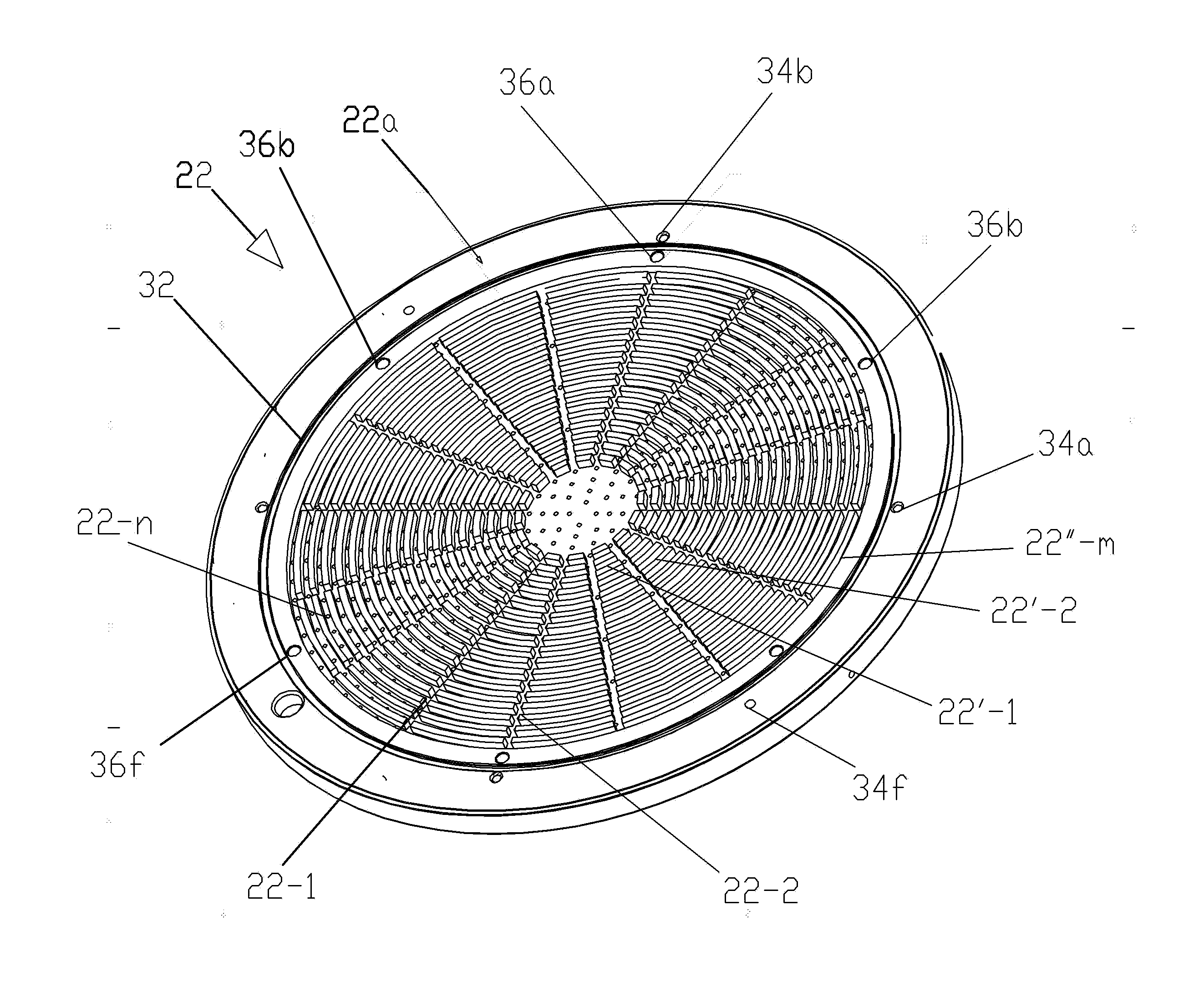Therefore, the
wafer surface area has increased by 2.25 times, and providing the required
plasma density for the
etching process becomes a problem.
This drastically reduces reliability and cost of the
system.
However, at frequencies much higher than 13.56, the electromagnetic effects cause some problems that deteriorate the uniformity of
plasma density.
All of these factors cause drastic changes in distribution of plasma density and
ion flux and eventually result in nonuniformity of
etching.
More specifically, exceeding the threshold gap depth leads to the same
instability that occurs when frequency exceeds rated value.
Furthermore, the polished contact surfaces at the periphery cannot be ideally even and may be contaminated.
Therefore, in an actual application we should expect that some RF power can be lost and some gas may leak through the gaps.
The plasma that is used for
etching semiconductor wafers is very corrosive.
Naturally, a showerhead that is used in such a process is subject to the effect of very chemically corrosive gasses, especially when etching the wafers with highly reactive radicals, and therefore the showerhead is subject to deterioration by
chemical corrosion.
Moreover, heavy ions generated during plasma discharge bombard the sharp edges at the exits of the gas holes where electrical strength is very high.
As a result, such exits are converted into craters, and this violates the etching process.
However, the showerhead is a very expensive item.
As a result, the uniformity of plasma density further deteriorates, which results in poor planar uniformity and charge-up damage to the
plasma etching.
With the increase of showerhead size and much higher frequency requested to support the optimal level of plasma density for maintaining uniformity in
dual frequency,
capacitively coupled plasma-etching systems become more complicated because of the electromagnetic and finite
wavelength effects that deteriorate this uniformity.
As RF frequency increases, the plasma-effective
wavelength decreases, and therefore the uniformity of the electrical field worsens.
Moreover, transition to sufficiently high frequencies shortens the wavelength and leads to some constructive and destructive interferences and
skin effects.
Therefore, depending on the frequency, the finite wavelength produces nonuniformities that are already problematic for 300-mm showerheads, and will become more critical for showerheads used in apparatuses treating wafers of 450 mm.
This phenomenon causes interference of the aforementioned wave with the counter-propagating
waves reflected from the rear sides of the showerhead.
Such changes in RF power distribution result in nonuniform RF
power deposition into plasma.
As a result, the
wafer treatment processes such as etching or deposition become nonuniform as well.
However, the
high resistivity part of the showerhead consumes too much RF power during
Joule heating, and this reduces the efficiency of the device.
As a result, it becomes more difficult to adjust the uniformity of plasma density.
A drawback of this method is a complicated, real-
time control of plasma uniformity that includes tuning the phases by oscillating the phases of the segments or the phase swapping to shift the pick of RF power distribution from the center to the middle.
The
metal ceramic neighboring at the processing surface of the showerhead deteriorates the plasma sheath, and the resulting
sputtering and
erosion contaminate the product.
However, manufacture of the showerhead with an accurate and smooth curvilinear surface is an extremely complicated, inefficient, and expensive procedure.
It is understood in this regard that in transition to 450-mm wafer etching systems, the above methods and constructions are less efficient than methods based on controlling gas distribution.
However, changing the geometry at the exits of the holes on the processing side of the showerhead is not recommended (see, for example, U.S. Pat. No. 6,333,601 issued to S. Wickramanayaka on Dec. 25, 2001, “Planar gas introducing unit of a CCP reactor”).
These ions
gain high energy, especially in vicinity of the sharp edges of the gas holes where density of the electrical field is high; thus, the bombardment of ions on the surface causes
sputtering of this surface.
This process causes an
erosion of the gas hole compared to the other areas of the showerhead, resulting in an enlargement in the
diameter of the gas holes.
However, during wafer processing, such as
plasma etching, the showerhead and cooler plate are heated, and the difference in their thermal expansions places high loads on the O-rings.
Besides a high temperature, the O-ring is also exposed to a highly corrosive etching gas.
As a result, the O-ring material degrades, thus contaminating the etching process.
Because processing gas leaks through the deteriorated O-ring, the pressure in each zone becomes out of control, and the etching process is deteriorated.
However, the apparatus has a complicated structure, strict tolerances, and must be very carefully designed just for a single-process protocol.
Another factor that causes nonuniformity of
plasma treatment is deterioration of gas distribution channels that supply the processing gas from gas accumulation to plasma treatment through the showerhead.
However, since a showerhead surface is under high-
voltage RF, the plasma
treatment procedure is jeopardized by the highly destructive electrical processes.
This leads to the loss of power and
distortion of the passage geometry, and, hence, to
instability in technological parameters of the process.
This leads to drastic lowering of the resistance of
silicon to sputtering and etching.
Such a mismatching may be caused by variations in
chamber pressure, RF power, etc.
This arcing leads to destruction of the showerhead and, hence, to nonuniform distribution of processing gas in the plasma cavity, as well as to
contamination of processing gas and of the product with particles of the showerhead material.
It should be further noted that the deterioration described above is not uniform and has a different degree in different areas of the showerhead.
This leads to shortening of the channel lengths in the
peripheral part of the showerhead, which leads to decrease in
gas pressure in the space in the
peripheral areas of the processing chamber.
This, in turn, leads to the nonuniformity of plasma.
 Login to View More
Login to View More 


